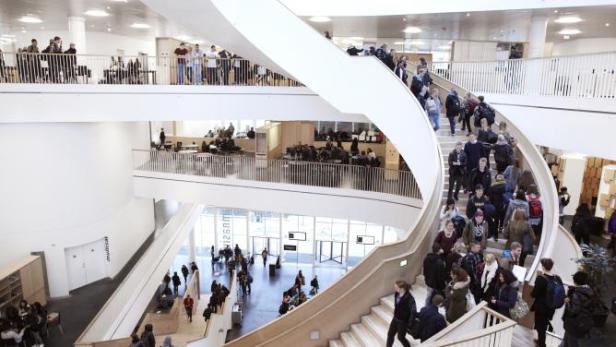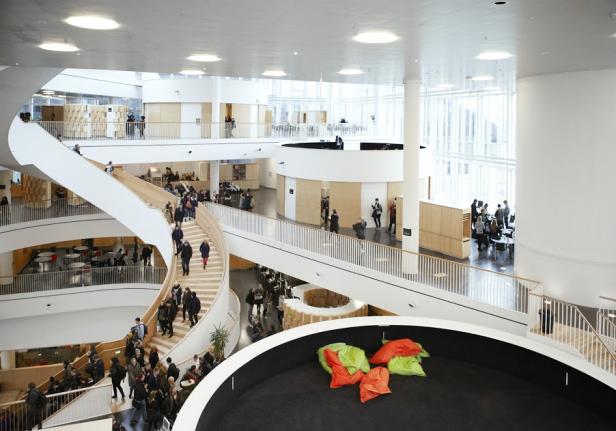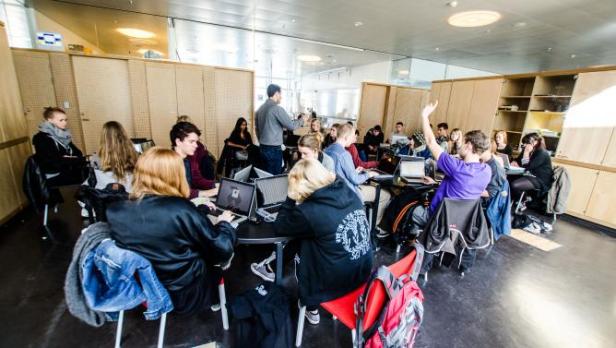
Smart School: “No one misses textbooks”
Dieser Artikel ist älter als ein Jahr!
"Our students have not seen textbooks in years. Even though I am a fan of books myself, I think that digital media are the future. No students miss textbooks," Kjaer Andersen said during his presentation in Krems. At Oerestad Gymnasium in Copenhagen, each student has a laptop or tablet. Five years ago, the school began switching to digital teaching materials. Textbooks were eliminated.
"But it only works when teachers prepare their own teaching materials and share them with other teachers. We introduced a rule that teachers can use materials from other teachers in their first year. Starting in their second year, they must create materials themselves and share them with others. This is obligatory," Kjaer Andersen explained.

© Philip Oerneborg
Teachers share materials and knowledge
At the secondary school, which is attended by about one thousand 16- to 19-year-olds, there are separate organizational units for teachers. They work together in groups, share their knowledge with each other, help each other with lesson planning and exchange digital teaching materials. "This is very important and requires major organizational changes compared to a conventional school," Kjaer Andersen said.
When it made the change, the school gave every teacher the choice of switching to the digital classroom or changing schools, whichever they preferred. Many of them stayed, and for those who did, there were immediately clear rules about how to use the new technology. "If you let them, teachers slip back into old patterns without even intending to. We wanted to prevent that."
Students work with digital media
But the digital classroom at Oerestad Gymnasium is not only managed by the teachers, it also requires a high level of participation by the students. "We believe in the students playing an active role in the learning process. There is a wide range of interactive materials for this that also facilitate and promote group work," Kjaer Andersen explained. Students write blog entries, produce podcasts and use different media to express themselves in a separate "virtual room." This creative use of media and communication is a cornerstone of the teaching approach. "We are not yet entirely done with our transition, but it turned out not to be as hard as we thought it would be. I think that every school should try it out!"

© Philip Oerneborg
Unique space concept
Oerestad Gymnasium also meets the space requirements for implementing such a school concept. The school was built by the architect team 3xN (Three Times Nielsens) in 2005 after the Danish school reform, and was an example of how the broad educational reorientation in Denmark could work from the very start.
The building consists of a giant box structure with plenty of open space and a large, wide staircase around this area that can be used to study or take breaks. There are very few traditional classrooms. The only dedicated rooms are for classes where new information is being taught. Otherwise, there are group areas, meeting points, individual areas and lecture halls for events, the principal said. When the weather permits, classes are also held on the roof and in the open spaces around the school building, for example right on the water.
"Bring your own device" is problematic
However, not everything went smoothly from the start at the school in Copenhagen after the switch. Especially the "bring your own device" concept caused problems. This was very expensive for the students, and was not always effective. "It is much easier to run a class with a single technology, because the teachers are also familiar with it. A teacher cannot be an expert for all devices, but this is expected when we have a `bring your own device` policy.
Starting next year, all incoming classes (16-year-old students) will be given iPads," Kjaer Andersen explained. The school has the same budget as every other school in Denmark. Financing the iPads for the school is a "matter of allocating the budget," the principal said.

© Philip Oerneborg
Copyright as an issue with teaching materials
The most complicated technical factor was installing WIFI connections in all of the classrooms, and making sure that they would not fail when students use them with multiple devices. The biggest problem in the beginning was copyright restrictions, because you cannot simply digitize printed teaching materials and use them in the classroom. "We want our teaching to be legal. We use digital textbooks under license, free Internet resources and materials that are produced by teachers and students."
Kjaer Andersen has the following recommendation for schools that want to implement the Oerestad concept: "Networking is very important. It is very bad for schools when they cut themselves off from the outside world. We never would have been able to digitize our teaching without cooperating with other schools, universities and networks." Kjaer Andersen added, "That is important for inspiration and for the teams."
Idea competition
What should the classroom of the future look like, how should it work, and what do students expect in the classroom?
futurezone.at and Samsung have launched the Samsung Smart School idea competition, which is being supported by the Federal Ministry for Education, Art and Culture. Further information and participation terms can be found here.
Kommentare